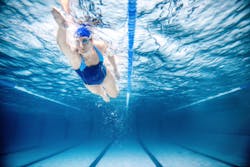Engineers win competition for water-cleaning swimsuit design
RIVERSIDE, Calif. — Oct. 12, 2015 — Engineers from the University of California, Riverside, won an international design competition for their contribution to a swimsuit that cleans water as a person swims, according to a press release.
The engineers created Sponge for the suit, a reusable material made from heated sucrose, a form of sugar, noted the release. Sponge is highly porous and super hydrophobic, meaning it repeals water in addition to absorbing harmful contaminants.
"This is a super material that is not harmful to the environment and very cost effective to produce," said Mihri Ozkan, an electrical engineering professor at UC Riverside’s Bourns College of Engineering, in the release.
An illustration shows how the material works.
Ozkan and her husband and fellow engineering professor Cengiz Ozkan, Ph.D. student Daisy Patino and Hamed Bay, a new Ph. D. graduate, have worked on the material for four years, reported the release. Sponge was originally created for applications such as cleaning oil or chemical spills or desalinizing water.
The researchers claim the material can also be used in airplane and satellite paint as well as part of electromagnetic shields for things like unmanned aerial vehicles, shared the release. Partners of architecture and design firm Eray Carbajo came up with the idea to use the material in wearable technology.
The firm’s team worked with the researchers to design the swimsuit, which won first place at the Reshape 15 Wearable Technology Competition, stated the release.
The material can absorb up to 25 times its own weight, noted the release. Contaminants absorbed do not touch the skin because they are trapped in the inner pores of the sponge material. Sponge can be reused up to 20 times before it loses absorbency.
View a video of the material in action here.
You can find the entire release here.
